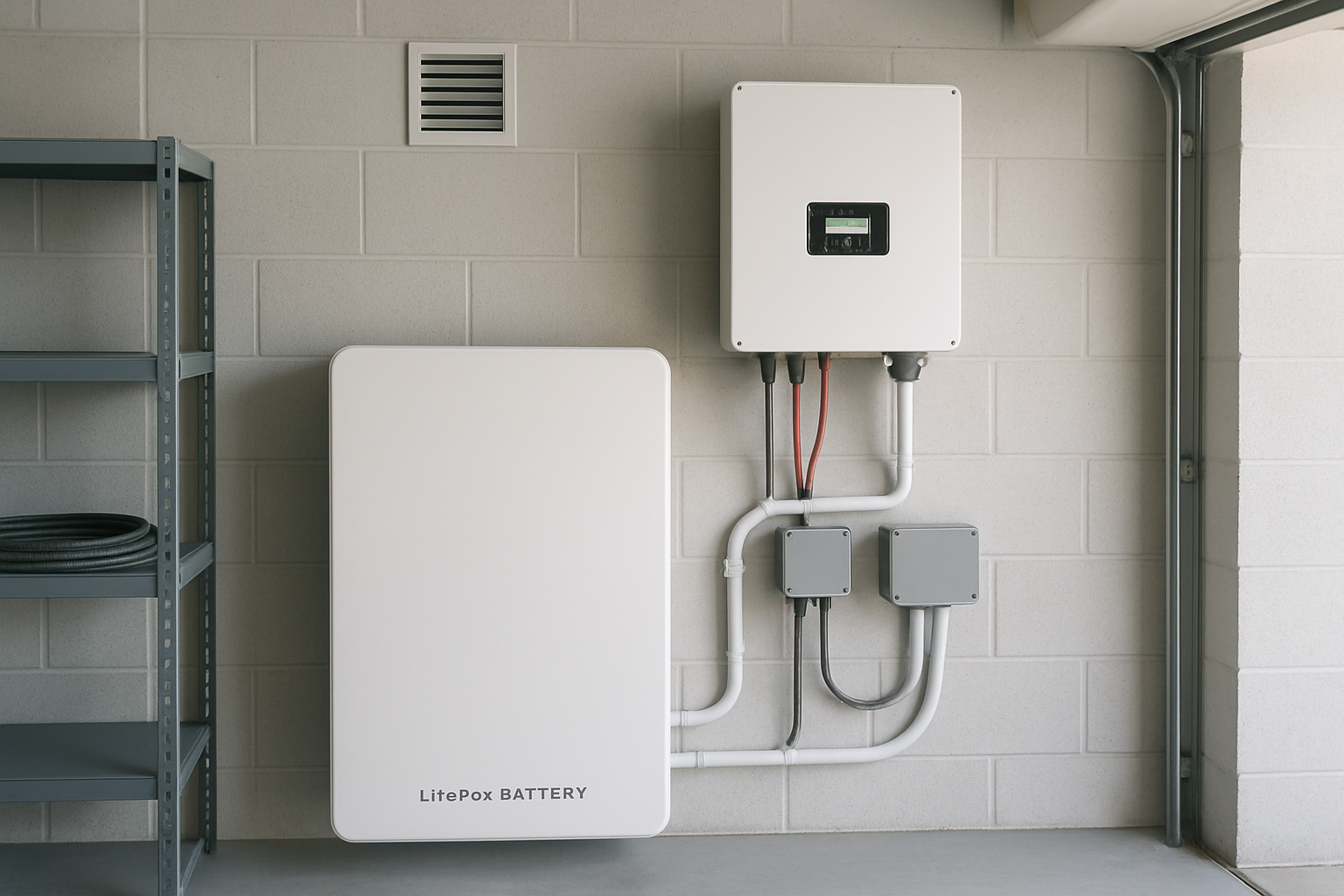As more homeowners adopt solar energy storage to gain independence from the grid, questions about the safety of these systems naturally arise. While headlines sometimes highlight incidents involving lithium-ion batteries, the reality for residential solar battery systems is much more nuanced. Modern systems are engineered with advanced safety features, making them a reliable part of a home's energy infrastructure. Understanding the technology and best practices is key to ensuring peace of mind.
Understanding the Real Risks of Solar Batteries
While any electrical system has inherent risks, the homeowner fire risk associated with modern solar energy storage is remarkably low. Reports indicate that professionally installed residential battery systems are responsible for a very small fraction of lithium-ion battery fires, which are more commonly linked to micromobility devices like e-scooters. In fact, data from Australia showed that in 2023, home battery systems accounted for only about 1% of lithium-ion battery fires attended by fire services in New South Wales. A German study found the annual fire risk probability for home storage systems to be just 0.0049%.
Battery Chemistry Matters: LiFePO4 vs. Others
The core of battery safety lies in its chemistry. Many high-quality residential solar battery systems use Lithium Iron Phosphate (LiFePO4) chemistry, which is known for its exceptional stability. Unlike other lithium-ion chemistries like Nickel Manganese Cobalt (NMC), LiFePO4 has a stronger molecular structure that is highly resistant to thermal runaway—a dangerous condition where a battery cell overheats uncontrollably. LiFePO4 batteries can withstand much higher temperatures before becoming unstable, making them a fundamentally safer choice for a home environment.
| Feature | LiFePO4 (LFP) | NMC |
|---|---|---|
| Thermal Stability | High (Stable up to 270°C) | Lower (Unstable around 210°C) |
| Fire Risk | Very Low | Higher |
| Cycle Lifespan | High (3,000-5,000+ cycles) | Lower (1,000-2,000 cycles) |
| Energy Density | Good | Very High |
The Role of the Battery Management System (BMS)
Beyond chemistry, every advanced solar energy storage system includes a Battery Management System (BMS). This onboard computer is the brain of the battery, continuously monitoring its vital signs. A quality BMS is critical for safety, as it prevents common causes of battery failure like overcharging, over-discharging, and operating outside of safe temperature ranges. It ensures all battery cells are balanced and functioning optimally, effectively acting as a first line of defense against potential hazards.
Key Factors Influencing Homeowner Fire Risk
Several factors contribute to the overall safety of a residential solar battery installation. By addressing these areas, homeowners can significantly minimize any potential risks.
Professional Installation and Proper Siting
Proper installation is non-negotiable for solar energy system fire prevention. A certified professional will ensure that all electrical connections are secure, the system is correctly configured, and it complies with local building and electrical codes. The location of the battery is also important. It should be installed in a well-ventilated area, away from direct heat sources and flammable materials, to ensure it operates within its ideal temperature range.
Environmental Conditions: Heat and Ventilation
Extreme temperatures can stress a battery system. Systems are designed with thermal management features, but proper ventilation is crucial to help dissipate heat generated during charging and discharging. Keeping the area around the battery clear of clutter allows for adequate airflow and helps the system maintain a safe operating temperature, extending its life and ensuring its reliability.
The Impact of System Age and Maintenance
Like any sophisticated equipment, a solar energy storage system benefits from regular check-ups. While modern systems, especially those with LiFePO4 batteries, require minimal user maintenance, periodic inspections are a good practice. Over time, connections can loosen or components can age. Following a simple maintenance schedule helps ensure the system continues to operate safely and efficiently for years to come.
How to Proactively Check Your Solar Battery's Safety
Empowering yourself with knowledge on how to check solar battery safety can provide additional confidence in your system. These simple checks can help you spot potential issues early.
Regular Visual Inspections
Periodically perform a visual check of your battery unit. Look for any signs of physical damage, such as cracks in the casing, bulging, or discoloration. Also, ensure that all vents are clear of dust and debris and that the connections appear secure and free of corrosion. This simple walk-around can help identify external issues before they become serious.
Monitoring System Performance Data
Most modern solar energy storage systems come with a monitoring app or web portal that provides real-time performance data. Keep an eye on your system's charging and discharging patterns. Any sudden drops in capacity, unusual error messages, or frequent shutdowns could signal an underlying issue that needs attention. Understanding these metrics is vital for efficiency and safety. For a comprehensive overview of key performance indicators, you can consult this ultimate reference on solar storage performance.
When to Call a Professional
If you notice any physical damage, receive persistent error codes, or observe a significant and unexplained decline in performance, it is time to contact a qualified solar installer. Do not attempt to open or service the battery yourself. Professionals have the right tools and training to diagnose and resolve issues safely.
Advanced Safety Features in Modern Energy Storage Systems
The solar energy industry is committed to safety, a fact reflected in the rigorous standards and certifications that govern product design and manufacturing.
Thermal Management Systems
Advanced residential solar battery systems incorporate sophisticated thermal management. This can include internal cooling fans or other mechanisms designed to maintain the battery cells at their optimal temperature. These systems are crucial for both safety and longevity, as they prevent overheating even during periods of heavy use or in warm climates.
Certifications and Safety Standards
When choosing a solar energy storage system, look for products that are certified to recognized safety standards. UL 9540 is a key standard for energy storage systems in North America, covering the entire system, including the battery, inverter, and control systems, to ensure they work together safely. This certification involves rigorous testing for electrical safety, fire detection, and thermal runaway prevention. The UL 9540A test method specifically evaluates fire propagation, providing critical data on how a system behaves in a worst-case thermal event.
Your Path to a Secure Energy Future
Investing in a solar energy storage system is a significant step toward energy independence. While the concern of fire risk is understandable, it is largely mitigated by modern technology, robust safety standards, and proper installation. By choosing a system with stable LiFePO4 chemistry, ensuring it is installed by a certified professional, and performing simple periodic checks, you can confidently and safely enjoy the benefits of stored solar power. The technology is designed for a secure, reliable, and long-lasting energy solution for your home.
Frequently Asked Questions
Are solar batteries safe to have in my home?
Yes, when properly installed and maintained, modern solar batteries are very safe. Systems using LiFePO4 chemistry are particularly noted for their stability and low fire risk. Furthermore, reputable products are subjected to rigorous testing to meet safety standards like UL 9540, which is designed to prevent electrical and fire hazards.
What are the warning signs of a failing solar battery?
Warning signs can include a noticeable decrease in how long the battery holds a charge, frequent system shutdowns, or error messages on the monitoring app. Physical signs like bulging or cracking of the battery case, or any fluid leaks, are serious indicators that require immediate professional attention.
How often should I have my solar energy storage system inspected?
It is a good practice to have your entire solar and storage system inspected by a qualified technician annually or according to the manufacturer's recommendation. Between professional visits, you should perform your own visual inspections monthly or quarterly to check for any obvious signs of damage or wear.





Leave a comment
All comments are moderated before being published.
This site is protected by hCaptcha and the hCaptcha Privacy Policy and Terms of Service apply.